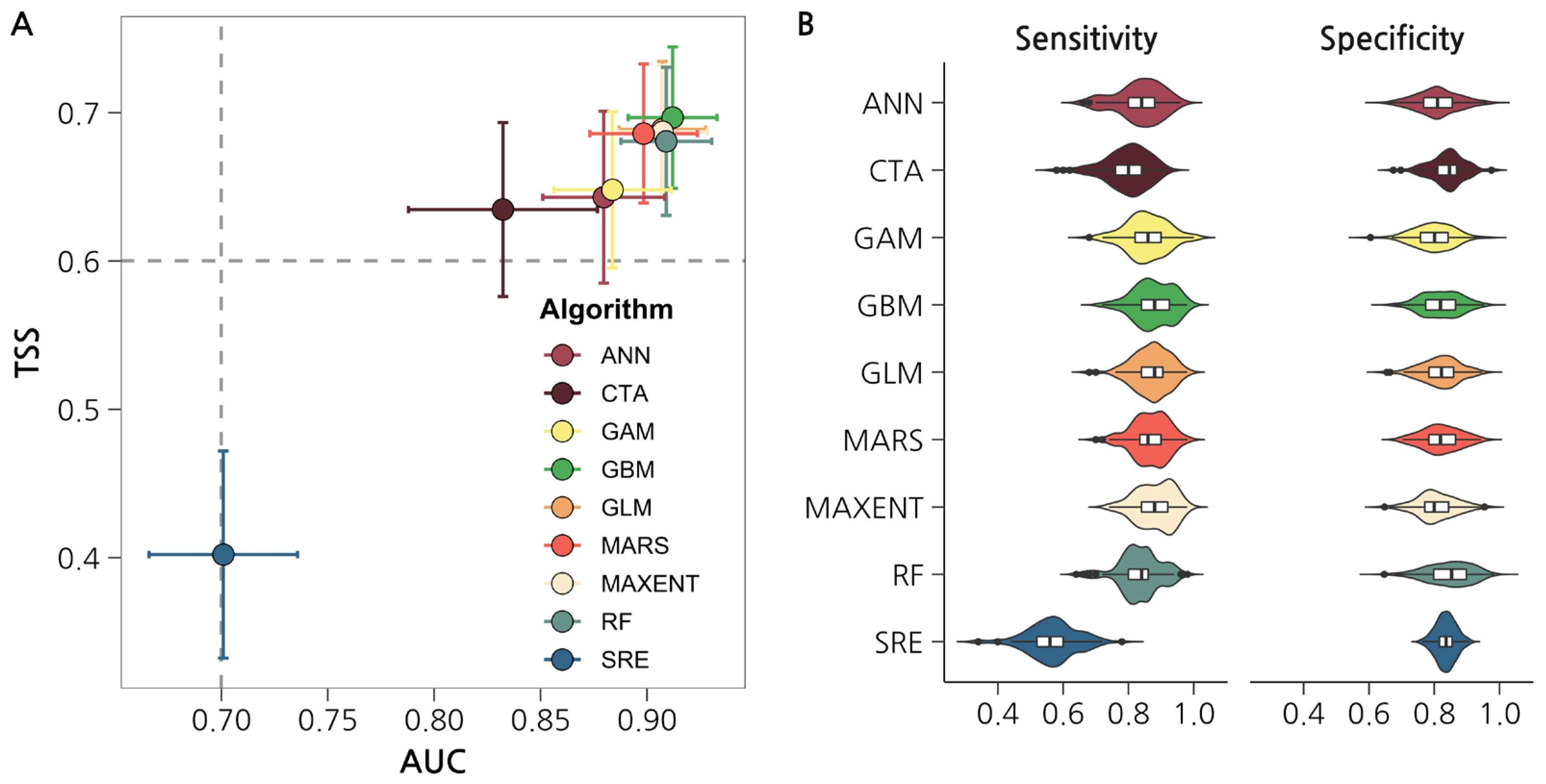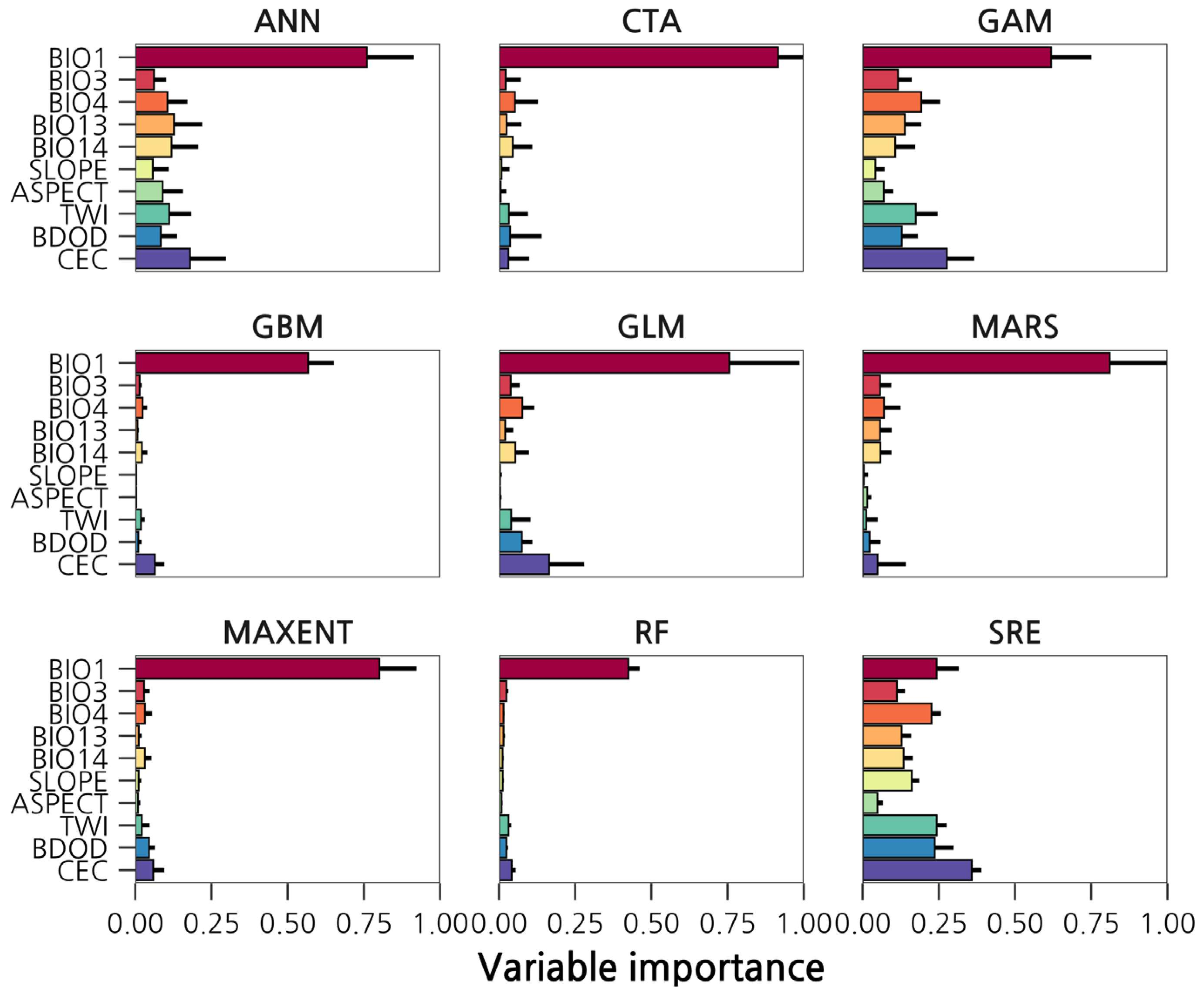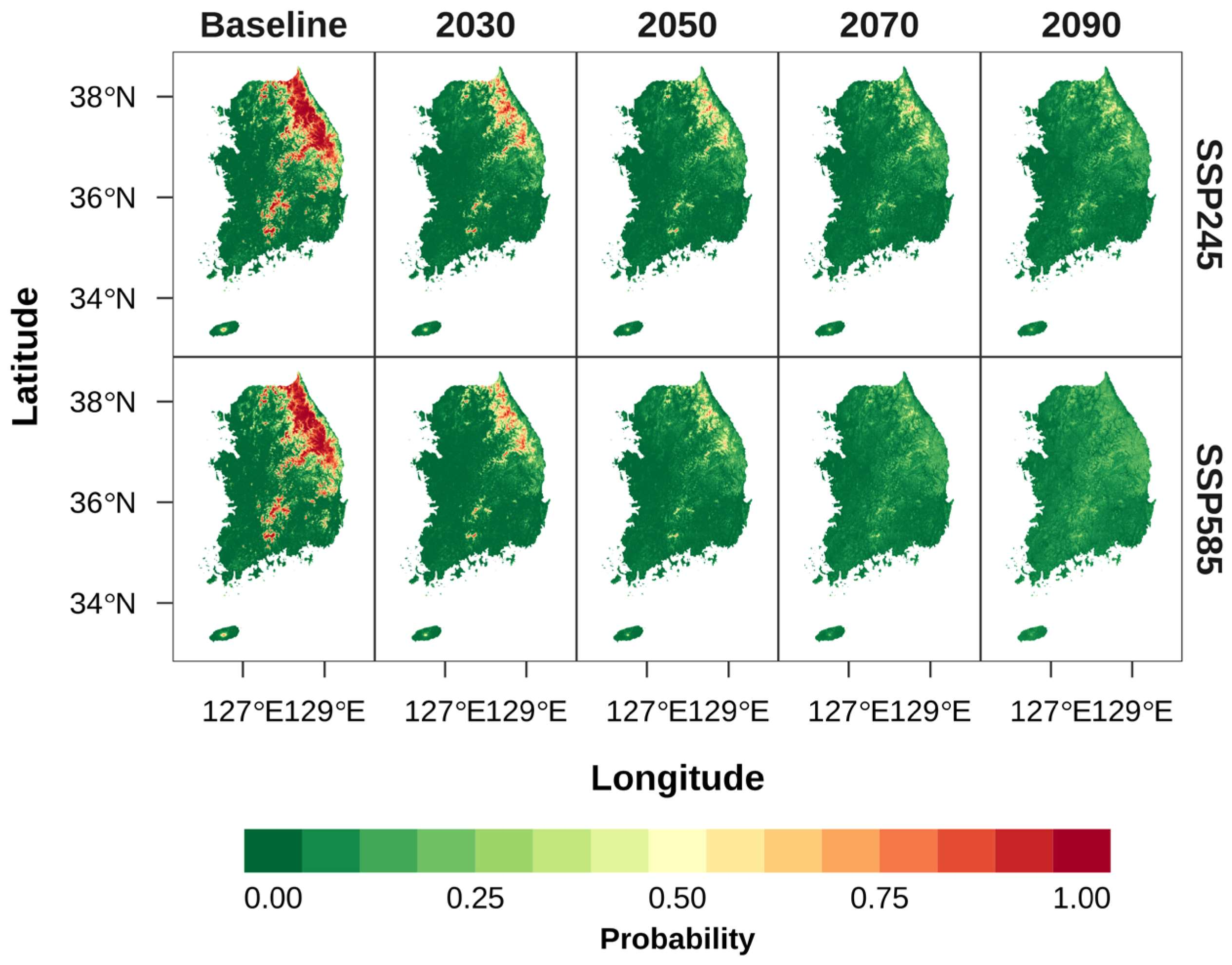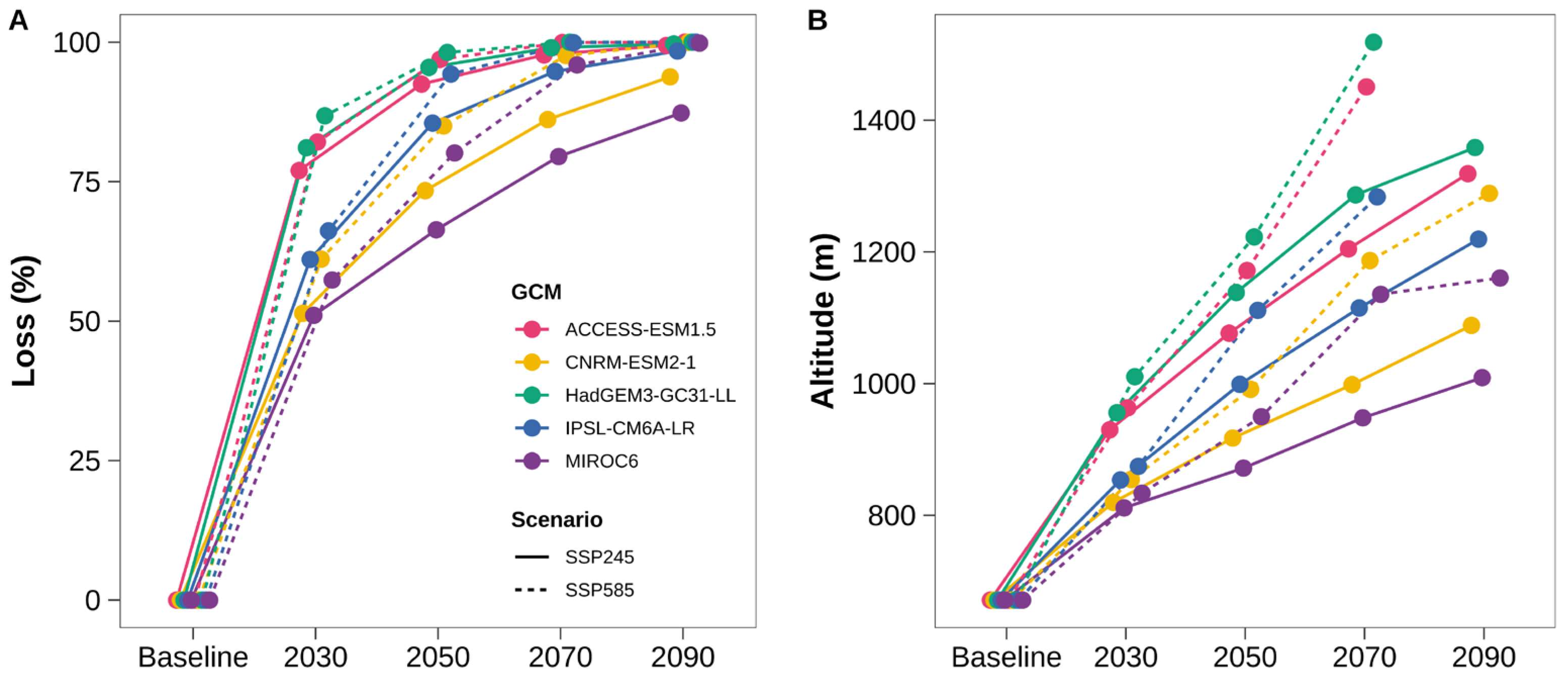Predicting the Habitat Suitability for Angelica gigas Medicinal Herb Using an Ensemble Species Distribution Model
Abstract
:1. Introduction
2. Materials and Methods
2.1. Collection of Species Occurrence Data
2.2. Selection of Environmental Variables
2.3. Development and Evaluation of the Species Distribution Model
2.4. Prediction of Ensemble Model
3. Results
3.1. Performance of the Single Algorithm and Ensemble Model
3.2. Habitat Suitability and Environmental Variable Contribution
3.3. Future Changes in Suitable Habitat
4. Discussion
5. Conclusions
Supplementary Materials
Author Contributions
Funding
Data Availability Statement
Acknowledgments
Conflicts of Interest
References
- Parmesan, C.; Yohe, G. A globally coherent fingerprint of climate change impacts across natural systems. Nature 2003, 421, 37–42. [Google Scholar] [CrossRef] [PubMed]
- Hickling, R.; Roy, D.B.; Hill, J.K.; Fox, R.; Thomas, C.D. The distributions of a wide range of taxonomic groups are expanding polewards. Glob. Change Biol. 2006, 12, 450–455. [Google Scholar] [CrossRef]
- Kelly, A.E.; Goulden, M.L. Rapid shifts in plant distribution with recent climate change. Proc. Natl. Acad. Sci. USA 2008, 105, 11823–11826. [Google Scholar] [CrossRef] [Green Version]
- National Institute of Biological Resources (NIBR). The Effect of Climate Change on Biogeographical Subregions in Korea; National Institute of Biological Resources: Incheon, Republic of Korea, 2009; p. 167.
- Barbet-Massin, M.; Jetz, W. The effect of range changes on the functional turnover, structure and diversity of bird assemblages under future climate scenario. Glob. Change Biol. 2015, 21, 2917–2928. [Google Scholar] [CrossRef]
- Baker, D.J.; Maclean, I.M.D.; Goodall, M.; Gaston, K.J. Species distribution modelling is needed to support ecological impact assessments. J. Appl. Ecol. 2021, 58, 21–26. [Google Scholar] [CrossRef]
- Pecchi, M.; Marchi, M.; Burton, V.; Giannetti, F.; Moriondo, M.; Bernetti, I.; Bindi, M.; Chirici, G. Species distribution modelling to support forest management. A literature review. Ecol. Model. 2019, 411, 108817. [Google Scholar] [CrossRef]
- Barry, S.; Elith, J. Error and uncertainty in habitat models. J. Appl. Ecol. 2006, 43, 413–423. [Google Scholar] [CrossRef]
- Syphard, A.D.; Franklin, J. Differences in spatial predictions among species distribution modeling methods vary with species traits and environmental predictors. Ecography 2009, 32, 907–918. [Google Scholar] [CrossRef]
- De Marco, P.J.; Nobrega, C.C. Evaluating collinearity effects on species distribution models: An approach based on virtual species simulation. PLoS ONE 2018, 13, e0202403. [Google Scholar] [CrossRef]
- Choi, J.Y.; Lee, S.H. Climate change impact assessment of Abies nephrolepis (Trautv.) Maxim. in subalpine ecosystem using ensemble habitat suitability modeling. J. Korean Environ. Res. Technol. 2018, 21, 103–118. [Google Scholar]
- Lee, S.; Jung, H.; Choi, J. Projecting the impact of climate change on the spatial distribution of six subalpine tree species in South Korea using a multi-model ensemble approach. Forests 2021, 12, 37. [Google Scholar] [CrossRef]
- Heikkinen, R.K.; Luoto, M.; Araujo, M.B.; Virkkala, R.; Thuiller, W.; Sykes, M.T. Methods and uncertainties in bioclimatic envelope modelling under climate change. Prog. Phys. Geogr. 2006, 30, 751–777. [Google Scholar] [CrossRef] [Green Version]
- Araujo, M.B.; New, M. ensemble forecasting of species distributions. Trends Ecol. Evol. 2007, 22, 42–47. [Google Scholar] [CrossRef]
- Marmion, M.; Parviainen, M.; Luoto, M.; Heikkinen, R.K.; Thuiller, W. Evaluation of consensus methods in predictive species distribution modelling. Divers. Distrib. 2009, 15, 59–69. [Google Scholar] [CrossRef]
- Grenouillet, G.; Buisson, L.; Casajus, N.; Lek, S. Ensemble modelling of species distribution: The effects of geographical and environmental ranges. Ecography 2011, 34, 9–17. [Google Scholar] [CrossRef]
- Hao, T.; Elith, J.; Guillera-Arroita, G.; Lahoz-Monfort, J.J. A review of evidence about use and performance of species distribution modelling ensembles like BIOMOD. Divers. Distrib. 2019, 25, 839–852. [Google Scholar] [CrossRef]
- Kwon, H.S. Applying ensemble model for identifying uncertainty in the species distribution models. J. Korean Geospat. Inf. Syst. 2014, 22, 47–52. [Google Scholar]
- Ahn, Y.; Lee, D.; Kim, H.G.; Park, C.; Kim, J.; Kim, J. Estimating Korean pine (Pinus koraiensis) habitat distribution considering climate change uncertainty using species distribution models and RCP scenarios. J. Korean Environ. Res. Technol. 2015, 18, 51–64. [Google Scholar]
- Lee, S.A.; Lee, S.H.; Ji, S.Y.; Choi, J. Predicting change of suitable plantation of Schisandra chinensis with ensemble of climate change scenario. J. Environ. Impact Assess. 2016, 25, 77–87. [Google Scholar] [CrossRef] [Green Version]
- Koo, K.A.; Park, S.U.; Kong, W.S.; Hong, S.; Jang, I.; Seo, C. Potential climate change effects on tree distributions in the Korean peninsula: Understanding model & climate uncertainties. Ecol. Model. 2017, 353, 17–27. [Google Scholar]
- Wenger, S.J.; Som, N.A.; Dauwalter, D.C.; Isaak, D.J.; Neville, H.M.; Luce, C.H.; Dunham, J.B.; Young, M.K.; Fausch, K.D.; Rieman, B.E. Probabilities accounting of uncertainty in forecasts of species distributions under climate change. Glob. Chang. Biol. 2013, 19, 3343–3354. [Google Scholar] [PubMed]
- Fordham, D.A.; Wigley, T.M.L.; Brook, B.W. Multi-model climate projections for biodiversity risk assessments. Ecol. Appl. 2011, 21, 3317–3331. [Google Scholar] [CrossRef]
- Buisson, L.; Thuiller, W.; Casajus, N.; Lek, S.; Grenouillet, G. Uncertainty in ensemble forecasting of species distribution. Glob. Change Biol. 2010, 16, 1145–1157. [Google Scholar] [CrossRef]
- Choo, B.K.; Ji, Y.; Moon, B.C.; Lee, A.Y.; Chun, J.M.; Yoon, T.; Kim, H.K. A study on environment characteristics of the Angelica gigas Nakai population. J. Korean Environ. Res. Technol. 2009, 12, 92–100. [Google Scholar]
- Park, Y.; Jeong, D.; Sim, S.; Kim, N.; Park, H.; Jeon, G. The characteristics of growth and active compounds of Angelica gigas Nakai population in Mt. Jeombong. Korean J. Plant Res. 2019, 32, 9–18. [Google Scholar]
- Park, Y.; Park, P.S.; Jeong, D.H.; Sim, S.; Kim, n.; Park, H.; Jeon, K.S.; Um, Y.; Kim, M.J. The characteristics of the growth and the active compounds of Angelica gigas Nakai in cultivation sites. Plants 2020, 9, 823. [Google Scholar] [CrossRef]
- Ahn, S.D.; Yu, C.Y.; Seo, J.S. Effect of temperature and daylength on growth and bolting of Angelica gigas Nakai. Korean J. Med. Crop Sci. 1994, 2, 20–25. [Google Scholar]
- Korean Rural Economic Institute (KREI). Strategies for the Promotion of Regional Industry with Medicinal Herbs; Korea Rural Economic Institute: Seoul, Republic of Korea, 2008; p. 189. [Google Scholar]
- Jeong, D.H.; Kim, K.Y.; Park, S.H.; Jung, C.R.; Jeon, K.S.; Park, H.W. Growth and useful component of Angelica gigas Nakai under high temperature stress. Korean J. Plant Res. 2021, 34, 287–296. [Google Scholar]
- Kim, Y.G.; Ahn, Y.S.; An, T.J.; Yeo, J.H.; Park, C.B.; Park, H.K. Effect of yield and decursin content according to the accumulative temperature and seedling size in cultivation areas of Angelica gigas Nakai. Korean J. Med. Crop Sci. 2009, 17, 458–463. [Google Scholar]
- Kim, N.S.; Jeon, K.S.; Lee, H.S. Characteristic of growth and active ingredient in Angelica gigas Nakai according to forest environment by climate zone. Korean J. Med. Crop Sci. 2020, 28, 221–228. [Google Scholar] [CrossRef]
- Taccoen, A.; Piedallu, C.; Seynave, I.; Gegout-Petit, A.; Gegout, J.C. Climate change-induced background tree mortality is exacerbated towards the warm limits of the species ranges. Ann. For. Sci. 2022, 79, 23. [Google Scholar] [CrossRef]
- Rural Development Administration (RDA). Impact Assessment Based on Climate Change Scenario (RCP) in Apple, Grape, Mandarin, Ginseng, Cnidium, and Korean Angelica; Rural Development Administration: Suwon, Republic of Korea, 2007; p. 298.
- National Institute of Ecology (NIE). EcoBank. 2022. Available online: https://www.nie-ecobank.kr (accessed on 19 September 2022).
- Global Biodiversity Information Facility (GBIF). Angelica gigas Nakai. 2022. Available online: https://www.gbif.org/species/5537749 (accessed on 13 September 2022).
- Park, Y. Comparison of Growth and Active Compounds of Angelica gigas between Habitats and Cultivation Sites. Ph.D. Thesis, Seoul National University, Seoul, Republic of Korea, 2018. [Google Scholar]
- Fick, S.E.; Hijmans, R.J. WorldClim 2: New 1 km spatial resolution climate surfaces for global land areas. Int. J. Climatol. 2017, 37, 4302–4315. [Google Scholar] [CrossRef]
- Dai, T.; Dong, W.; Guo, Y.; Hong, T.; Ji, D.; Yang, S.; Tian, D.; Wen, X.; Zhu, X. Understanding the abrupt climate change in the mid-1970s from a phase-space transform perspective. J. Appl. Meteor. Climatol. 2018, 57, 2551–2560. [Google Scholar] [CrossRef]
- Sarkar, S.; Maity, R. Global climate shift in 1970s causes a significant worldwide increase in precipitation extremes. Sci. Rep. 2021, 11, 11574. [Google Scholar] [CrossRef]
- Ziehn, T.; Chamberlain, M.; Lenton, A.; Law, R.; Bodman, R.; Dix, M.; Wang, Y.; Dobrohotoff, P.; Srbinovsky, J.; Stevens, L.; et al. CSIRO ACCESS-ESM1.5 Model Output Prepared for CMIP6 ScenarioMIP. Earth System Grid Federation. 2019. Available online: https://www.wdc-climate.de/ui/cmip6?input=CMIP6.ScenarioMIP.CSIRO.ACCESS-ESM1-5 (accessed on 5 October 2022).
- Seferian, R. CNRM-CERFACS CNRM-ESM2-1 Model Output Prepared for CMIP6 ScenarioMIP. Earth System Grid Federation. 2019. Available online: https://www.wdc-climate.de/ui/cmip6?input=CMIP6.ScenarioMIP.CNRM-CERFACS.CNRM-ESM2-1 (accessed on 5 October 2022).
- Good, P. MOHC HadGEM3-GC31-LL Model Output Prepared for CMIP6 ScenarioMIP. Earth System Grid Federation. 2019. Available online: https://www.wdc-climate.de/ui/cmip6?input=CMIP6.ScenarioMIP.MOHC.HadGEM3-GC31-LL (accessed on 5 October 2022).
- Boucher, O.; Denvil, S.; Levavasseur, G.; Cozic, A.; Caubel, A.; Foujols, M.; Meurdesoif, Y.; Cadule, P.; Devilliers, M.; Dupont, E.; et al. IPSL IPSL-CM6A-LR Model Output Prepared for CMIP6 ScenarioMIP. Earth System Grid Federation. 2019. Available online: https://www.wdc-climate.de/ui/cmip6?input=CMIP6.ScenarioMIP.IPSL.IPSL-CM6A-LR (accessed on 5 October 2022).
- Shiogama, H.; Abe, M.; Tatebe, H. MIROC MIROC6 Model Output Prepared for CMIP6 ScenarioMIP. Earth System Grid Federation. 2019. Available online: https://www.wdc-climate.de/ui/cmip6?input=CMIP6.ScenarioMIP.MIROC.MIROC6 (accessed on 5 October 2022).
- Danielson, J.J.; Gesch, D.B. Global Multi-Resolution Terrain Elevation Data 2010 (GMTED2010); U.S. Geological Survey: South Dakota, SD, USA, 2011; p. 26.
- Korea Institute of Geoscience and Mineral Resources (KIGMR). Topographic Wetness Index. 2019. Available online: https://www.bigdata-environment.kr/user/data_market/detail.do?id=aaa8c7b0-313f-11ea-adf5-336b13359c97 (accessed on 5 October 2022).
- Poggio, L.; de Sousa, L.M.; Batjes, N.H.; Heuvelink, G.B.M.; Kempen, B.; Ribeiro, E.; Rossiter, D. SoilGrids 2.0: Producing soil information for the globe with quantified spatial uncertainty. Soil 2021, 7, 217–240. [Google Scholar] [CrossRef]
- Dormann, C.F.; Elith, J.; Bacher, S.; Buchmann, C.; Carl, G.; Carre, G.; Marquez, J.R.G.; Gruber, B.; Lafourcade, B.; Leitao, P.J.; et al. Collinearity: A review of methods to deal with it and a simulation study evaluating their performance. Ecography 2013, 36, 27–46. [Google Scholar] [CrossRef]
- Thuiller, W.; Lafourcade, B.; Engler, R.; Araujo, M.B. BIOMOD—A platform for ensemble forecasting of species distributions. Ecography 2009, 32, 369–373. [Google Scholar] [CrossRef]
- Fielding, A.H.; Bell, J.F. A review of methods for the assessment of prediction errors in conservation presence/absence models. Environ. Conserv. 1997, 24, 38–49. [Google Scholar] [CrossRef]
- Allouche, O.; Tsoar, A.; Kadmon, R. Assessing the accuracy of species distribution models: Prevalence, kappa and the true skill statistic (TSS). J. Appl. Ecol. 2006, 43, 1223–1232. [Google Scholar] [CrossRef]
- Duque-Lazo, J.; Van Gils, H.; Groen, T.A.; Navarro-Cerrillo, R.M. Transferability of species distribution models: The case of Phytophthora cinnamomic in Southwest Spain and Southwest Australia. Ecol. Model. 2016, 320, 62–70. [Google Scholar] [CrossRef]
- Hakkinen, H.; Petrovan, S.O.; Sutherland, W.J.; Pettorelli, N. Terrestrial or marine species distribution model: Why not both? a case study with seabirds. Ecol. Evol. 2021, 11, 16634–16646. [Google Scholar] [CrossRef] [PubMed]
- Gallien, L.; Douzet, R.; Pratte, S.; Zimmermann, N.E.; Thuiller, W. Invasive species distribution models how violating the equilibrium assumption can create new insights. Glob. Ecol. Biogeogr. 2012, 21, 1126–1136. [Google Scholar] [CrossRef]
- R Core Team. A Language and Environment for Statistical Computing; R Foundation for Statistical Computing: Vienna, Austria, 2022. [Google Scholar]
- Crimmins, S.M.; Dobrowski, S.Z.; Mynsberge, A.R. Evaluating ensemble forecasts of plant species distribution under climate change. Ecol. Model. 2013, 266, 126–130. [Google Scholar] [CrossRef]
- Hao, T.; Elith, J.; Lahoz-Monfort, J.J.; Guillera-Arroita, G. Testing whether ensemble modelling is advantageous for maximising predictive performance of species distribution models. Ecography 2020, 43, 549–558. [Google Scholar] [CrossRef] [Green Version]
- Raes, N.; ter Steege, H. A null-model for significance testing of presence only species distribution models. Ecography 2007, 30, 727–736. [Google Scholar] [CrossRef]
- Valavi, R.; Guillera-Arroita, G.; Lahoz-Monfort, J.J.; Elith, J. Predictive performance of presence only species distribution models: A benchmark study with reproducible code. Ecol. Monogr. 2022, 92, e01486. [Google Scholar] [CrossRef]
- Henderson, A.F.; Santoro, J.A.; Kremer, P. Ensemble modeling for American chestnut distribution: Locating potential restoration sites in Pennsylvania. Front. Ecol. Evol. 2022, 1, 942766. [Google Scholar] [CrossRef]
- Elith, J.; Leathwick, J.R.; Hastie, T. A working guide to boosted regression trees. J. Anim. Ecol. 2008, 77, 802–813. [Google Scholar] [CrossRef]
- Wisz, M.S.; Hijmans, R.J.; Li, J.; Peterson, A.T.; Graham, C.H.; Guisan, A. Effects of sample size on the performance of species distribution models. Divers. Distrib. 2008, 14, 763–773. [Google Scholar] [CrossRef]
- Yu, H.S.; Park, C.H.; Park, C.G.; Kim, Y.G.; Park, H.W.; Seong, N.S. Growth characteristics and yield of the three species of genus Angelica. Korean J. Med. Crop Sci. 2004, 12, 43–46. [Google Scholar]
- Cho, S.H.; Kim, K.J. Studies on the increased of germination percent of Angelica gigas Nakai—I. Germination characteristics and cause of lower germination percent. Korean J. Med. Crop Sci. 1993, 1, 3–9. [Google Scholar]
- Choi, S.K.; Yun, K.W. Temperature effect on seed germination and seedling growth of Angelica acutilobu. Korean J. Plant Res. 2002, 5, 192–195. [Google Scholar]
- Song, C.K.; Park, Y.M.; Cho, N.K.; Ko, Y.W.; Kang, D.I. Growth responses of some medicinal plants in different altitudes of mountain Halla. Korean J. Med. Crop Sci. 2000, 8, 134–145. [Google Scholar]
- Chang, S.M.; Choi, j. Variation mode of the absorption contents of N, P and K and the contents of available constituents of Angelica gigas Nakai at different growth stages. Appl. Biol. Chem. 1986, 29, 392–398. [Google Scholar]
- Ministry of Agriculture, Food and Rural Affairs (MAFRA). 2021 an Actual Output of Crop for a Special Purpose; Ministry of Agriculture, Food and Rural Affairs: Sejong, Republic of Korea, 2022; p. 250.
- Lee, T.B. Endemic and rare plants of Mt. Sorak. Seoul Natl. Univ. Coll. Agric. Res. 1984, 9, 1–6. [Google Scholar]
- Kim, D.H.; Park, H.W.; Park, C.G.; Sung, J.S.; Seong, N.K. Effects of insects on pollination in Angelica gigas Nakai and Angelica acutiloba Kitagawa. Korean J. Med. Crop Sci. 2006, 14, 217–220. [Google Scholar]
- Kim, G.T.; Lyu, D.P.; Kim, H.J. Floral characteristics of Labiatae and Umbelliferae flowers and insect pollinators in Korea. Korean J. Environ. Ecol. 2013, 27, 22–29. [Google Scholar]






| Source | ESCM | GBIF | NFI | NNES | Park (2018) | Total |
|---|---|---|---|---|---|---|
| Original occurrence | 150 | 62 | 10 | 46 | 17 | 285 |
| Thinned occurrence | 65 | 49 | 9 | 40 | 5 | 168 |
| Variable | Description | Abbreviation | Source |
|---|---|---|---|
| Climate | Annual mean temperature (°C) | BIO1 | WorldClim |
| Isothermality (×100) | BIO3 | ||
| Temperature seasonality (standard deviation × 100) | BIO4 | ||
| Precipitation of wettest month (mm) | BIO13 | ||
| Precipitation of driest month (mm) | BIO14 | ||
| Topography | Slope (in degree) | SLOPE | GMTED2010 |
| Aspect (in degree) | ASPECT | ||
| Topographic wetness index | TWI | KIGAM | |
| Soil | Bulk density (cg/cm3) | BDOD | SoilGrids |
| Cation exchange capacity (mmolc/kg) | CEC |
| SSP245 | SSP585 | |||||||
|---|---|---|---|---|---|---|---|---|
| GCM | 2030 | 2050 | 2070 | 2090 | 2030 | 2050 | 2070 | 2090 |
| ACCESS-ESM1.5 | 5780 (77.0) | 1887 (92.5) | 572 (97.7) | 146 (99.4) | 4491 (82.1) | 773 (96.9) | 16 (99.9) | - (100) |
| CNRM-ESM2-1 | 12,210 (51.4) | 6687 (73.4) | 3483 (86.1) | 1561 (93.8) | 9773 (61.1) | 3769 (85.0) | 603 (97.6) | 7 (99.9) |
| HadGEM3-GC31-LL | 4753 (81.1) | 1135 (95.5) | 252 (99.0) | 76 (99.7) | 3314 (86.8) | 462 (98.2) | 2 (99.9) | - (100) |
| IPSL-CM6A-LR | 9787 (61.1) | 3646 (85.5) | 1316 (94.8) | 398 (98.4) | 8499 (66.2) | 1434 (94.3) | 23 (99.9) | - (100) |
| MIROC6 | 12,303 (51.0) | 8450 (66.4) | 5148 (79.5) | 3188 (87.3) | 10,712 (57.4) | 4988 (80.2) | 1021 (95.9) | 40 (99.8) |
| Mean | 8967 (64.3) | 4361 (82.7) | 2154 (91.4) | 1074 (95.7) | 7358 (70.7) | 2285 (90.9) | 333 (98.7) | 9 (99.9) |
Disclaimer/Publisher’s Note: The statements, opinions and data contained in all publications are solely those of the individual author(s) and contributor(s) and not of MDPI and/or the editor(s). MDPI and/or the editor(s) disclaim responsibility for any injury to people or property resulting from any ideas, methods, instructions or products referred to in the content. |
© 2023 by the authors. Licensee MDPI, Basel, Switzerland. This article is an open access article distributed under the terms and conditions of the Creative Commons Attribution (CC BY) license (https://creativecommons.org/licenses/by/4.0/).
Share and Cite
Jung, J.B.; Park, G.E.; Kim, H.J.; Huh, J.H.; Um, Y. Predicting the Habitat Suitability for Angelica gigas Medicinal Herb Using an Ensemble Species Distribution Model. Forests 2023, 14, 592. https://doi.org/10.3390/f14030592
Jung JB, Park GE, Kim HJ, Huh JH, Um Y. Predicting the Habitat Suitability for Angelica gigas Medicinal Herb Using an Ensemble Species Distribution Model. Forests. 2023; 14(3):592. https://doi.org/10.3390/f14030592
Chicago/Turabian StyleJung, Jong Bin, Go Eun Park, Hyun Jun Kim, Jeong Hoon Huh, and Yurry Um. 2023. "Predicting the Habitat Suitability for Angelica gigas Medicinal Herb Using an Ensemble Species Distribution Model" Forests 14, no. 3: 592. https://doi.org/10.3390/f14030592





